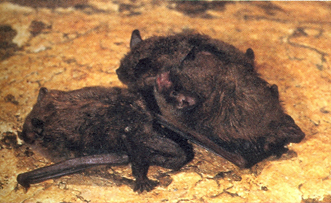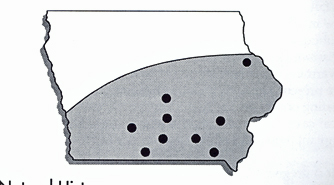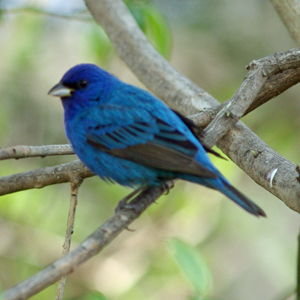Bats of Iowa
Vespertilionidae
Myotis sodalis (Miler and Allen)
Indiana Myotis or Indiana Bat


Etymology
Greek: Myotis - "mouse ear." Latin: sodalis - "companion."
Appearance
Fur: Dull grayish brown above, lighter below; hair basal two-thirds
brownish-black, narrow grayish subterminal band, brownish tip.
Tail membrane: Dark brown, sparsely haired near base. Wing membrane:
Dark brown, sparsely haired.
Calcar: keeled.
Ears: Short «16 mm), do not extend 2 mm beyond nostrils when laid
forward; blackish, naked, blunt tip. Tragus: About one-ear length;
blunt tip; not obviously curved.
Other: Hairs on toes sparse and not extending beyond claws.
Total length: 70-97 mm. Forearm: 35-41 mm. Wingspan: 240-267 mm.
Total weight: 5-8 g.
Tooth number and formula: 38 total; I 2/3, C 1/1, P 3/ 3, M 3/3.
Confusing Species
Little brown myotis (M. lucifugus): Fur glossy brown; calcar rarely
keeled, toe hairs longer than claws. Northern myotis (M.
septentionalis): Ears extend more than 2 mm beyond nostrils when
laid forward; tragus more than one-half ear length and pointed.
Eastern pipistrelle (P. subflavus): Fur yellowish; dark wing
membrane contrasting reddish forearm.
Distribution and Status
Overall: Primary population centers in Missouri, Indiana and
Kentucky; range includes Oklahoma, Iowa, Wisconsin east to Vermont
and south to northwest Florida.
Iowa: Southeastern one-third north to Jasper, Madison, Marion and
Dubuque Counties (see map below) .
Although all bats in Iowa are protected (Iowa Code 109.42), the
Indiana Bat is the only federally endangered mammal in the state.
The principal reason for this status is the potential for loss of a
significant portion of the population with destruction of any of the
few remaining over-wintering sites. Most of these bats hibernate in
very large clusters of about 100,000, chiefly in a few caves and
mines in Missouri, Indiana and Kentucky. The remainder are scattered
throughout the southern part of the winter range with a few as far
north as Dubuque County.
In summer, 50 or more females establish nursery colonies, chiefly
under bark of dead or dying trees along streams or upland forests.
In Iowa, sites with nursery colonies evidenced by pregnant or
lactating females have been located in south-central counties of
Appanoose, Decatur, Jasper, Louisa, Lucas, Madison, Marion, Monroe,
Van Buren and Wapello. Single young are born from late June to early
July, with the earliest born flying by the first week of July.
Recent studies in Illinois, Missouri and Michigan, suggest that
several roost trees may be used during the summer, probably
reflecting both seasonal microhabitat temperature changes and
dispersal from nurseries (Callahan 1993). Recent concern has focused
on loss of summer habitat because winter data show a continual
decline despite the protection of major hibernacula.
Females forage for insects in summer chiefly around the crowns of
trees in forest openings and along forest edges near the nursery.
Like most insectivorous bats, the Indiana myotis feeds on a variety
of small insects. Some studies suggest a shift by pregnant females
from eating soft-bodied insects (flies, moths and stone-flies) to
consuming those with harder bodies (beetles) later in the season.
In fall, most Indiana myotis migrate southward, but a few males and
females hibernate in mines and caves in Dubuque County and
presumably elsewhere along the Mississippi River. Although not
reported in Iowa, fall swarming of the species occurs when at least
some males are present. As with the other northern myotine bats,
mating occurs primarily during the fall, probably in or near caves.
However, details of ovulation, fertilization, implantation and early
pregnancy are poorly known.
Most pregnant females leave their hibernacula by late April and
migrate northward. A pregnant female captured in Marion County on 29
June 1979, for example, had been banded that spring at Pilot Knob
Mine, Iron County, Missouri (ca. 278 mile distance). Most females in
Iowa are believed to overwinter in central Missouri. On the other
hand, most males remain in the vicinity of the hibernacula
throughout most or all of the year; only three adult males have been
reported from Iowa.
The Indiana myotis was
placed on the federally endangered species list because of
population decline, chiefly due to human disturbance in the major
caverns of hibernation. Currently, 87 percent of the known
population use only seven primary wintering sites. Recovery plans
include protection of caves used by hibernating Indiana myotis (as
well as summer males), and nursery roost sites used by females in
the summer range. Presence of an adequate number of both nursery and
alternate roost trees may be critical for establishing and
maintaining viable populations


.jpg)
